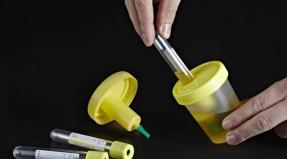Side effects of ketorol. What ketorol tablets help from and how much they cost. Special instructions for the use of Ketorol
The drug has become in demand due to its strong analgesic, moderate anti-inflammatory and antipyretic effects. Ketorol helps with joint, head, muscle pain. The tool is used in surgery, dentistry, orthopedics, neurology, gynecology, oncology.
The main substance of the medicine ketorolac tromethamine is one of the derivatives of pyrrolysinecarboxylic acid. The pharmaceutical composition appeared in 1980. A relatively new drug belongs to the group of non-steroidal anti-inflammatory drugs (NSAIDs or NSAIDs).


Ketorol tablets are intended for oral administration. There is a compressed white powder under the green filmy shell. The content of ketorolac in this dosage form is 10 mg. Auxiliary components are lactose, cellulose and other compounds.
Ketorol injections are called in everyday life a solution for intramuscular and intravenous injections. The volume of the ampoule is 1 ml, the concentration of ketorolac in the liquid is 30 mg / ml. Auxiliary components: sodium chloride and hydroxide, ethanol, etc.
The concentration of the active ingredient in the gel is 2%, which is 2 g for every 100 g of the drug. The total content of ketorolac in a tube weighing 30 g is 600 mg. In the reference books of medicines (RLS and Vidal) there are no Ketorol suppositories among the release forms of ketorolac. The same situation is in Belarus and Ukraine.
Pharmacological action, pharmacodynamics and pharmacokinetics
Ketorolac inhibits cyclooxygenase, an enzyme required for the synthesis of prostaglandins. These are mediators responsible for development inflammatory process accompanying it pain and the heat. The action on COX is due to the analgesic and anti-inflammatory effects of NSAIDs.

The pharmacological action of ketorolac determined the scope of its use - symptomatic treatment of pain syndrome.
Ketorol is a non-narcotic analgesic. However, the strong analgesic effect of the drug is often compared to that of opioids. Unlike the latter, ketorolac does not affect the central nervous system, is not a tranquilizer.
In 4-10 minutes after the absorption of the active substance into the blood, the pain syndrome is weakened. Healing effect lasts from 6 to 8 hours.
The absorption of ketorolac does not depend on the intake or availability of food in the gastrointestinal tract. Over 50% of the active substance that enters the body is converted in the liver into metabolites that do not have physiological activity. Excretion in the urine is more than 90%, less than 10% is excreted through the intestines.
What does Ketorol help from?
The causes of pain in which this drug is prescribed can be different. Most often, acute pain develops during inflammation, trauma, surgery, edema, muscle spasms.
Ketorol is used for the short-term treatment of moderate pain:
- for traumatic injuries, including bruises, dislocations, ligament injuries, tendonitis, bursitis, synovitis;
- with osteochondrosis, radiculitis;
- myalgia, arthralgia, neuralgia;
- with rheumatic diseases;
- with oncology.
The drug helps in cases of moderate to severe postoperative pain in patients in combination with low doses of narcotic analgesics. Ketorol is prescribed to reduce eye inflammation after cataract removal in adults.
What does Ketorol gel help from:
- pain in case of injuries, damage to ligaments;
- rheumatic diseases;
- post-traumatic pain;
- myalgia and arthralgia;
- radiculitis;
- neuralgia.
Ketorol does not affect the nature of the course of the causative disease. Symptomatic remedy only reduces the intensity of the inflammatory process, pain syndrome caused by injuries, inflammation.
Instructions for use and dosage
The choice of the form of release of the drug is dictated by the main indication and accompanying circumstances. Pain relief is achieved faster with intramuscular and intravenous administration. The latter method is used mainly in hospitals and nursing homes.
Ketorol tablets
Usually one tablet is taken for toothache, which corresponds to 10 mg of ketorolac. For injuries, myalgia and other indications, an increase in dosage may be required. Take one tablet every 4-6 hours. Maximum allowable daily dose- 40 g.

The duration of treatment for most NSAIDs is 3-7 days.
Ketorol is not prescribed for children under 12 years of age. Elderly people may need to reduce the dose recommended for adults to avoid adverse effects of the drug on the gastrointestinal tract.
Solution for intramuscular and intravenous administration
One ampoule of Ketorol contains 30 mg of the active ingredient. Experts suggest starting parenteral administration with a dose of 10 mg, then using 10–30 mg every 4–6 hours. Maximum single dose for the treatment of patients from 16 to 64 years old is 60 mg of ketorolac (2 ampoules of ketorol), the highest daily dose is 90 mg (3 ampoules).

If the patient's body weight is less than 50 kg and / or he is over 65 years old, then 15 or 30 mg (½ or 1 ampoule) is used once. A maximum of 2 ampoules can be administered per day.
Gel for external use
A single dose of ketorolac corresponds to a gel column about 1.5–2 cm long. The product is applied to clean, dry, intact skin within the area of soreness, evenly distributed with fingertips, rubbed in with gentle massaging movements. Apply the gel no more than 4 times a day. The course of treatment is from 3 to 10 days.

During pregnancy and breastfeeding
The drug is not prescribed for women who are expecting a baby, as well as during childbirth. Ketorolac has an undesirable effect on the contractile functions of the uterus, passes through the placenta (10% of the dose taken by the expectant mother). The use of the medication can lead to intrauterine pulmonary hypertension in newborns. If the doctor deems it necessary, he will prescribe Ketorol tablets or injections in the first and second trimesters of pregnancy.

Ketorolac is strictly contraindicated in the last three months of pregnancy and lactation.
If a nursing mother takes a Ketorol tablet, the active ingredient passes into breast milk. The drug reaches its maximum concentration after 2 hours. Before using the gel, pregnant or lactating women should consult a gynecologist or pediatrician.
Drug interactions
Simultaneous administration can enhance the negative effect of drugs on the gastrointestinal mucosa. Concomitant oral or parenteral use of Ketorol with other NSAIDs should be avoided, since in this case the risk of gastrointestinal bleeding increases.

And it is also undesirable to combine ketorolac with the following drugs:
- anticoagulants such as heparin and warfarin;
- platelet aggregation inhibitors;
- corticosteroids (GCS);
- calcium preparations;
- penoxyphylline.
The combined use of ketorolac with methotrexate, lithium salts leads to an increase in the concentration and toxicity of the latter. With simultaneous treatment, Ketorol reduces the effectiveness of antihypertensive drugs and diuretics. Paracetamol and ketorolac can be used together for no longer than 2 days. The combination of Ketorol with narcotic pain relievers can significantly reduce the dose of opioids.
Compatibility of Ketorol with alcohol
Ketorolac should not be taken with ethanol. Both substances, to varying degrees, irritate the gastrointestinal mucosa, which creates a risk of gastrointestinal bleeding.
Alcohol increases the rate of absorption and elimination of NSAIDs. The analgesic effect develops and ends faster, for the sake of which Ketorol is taken. There is a need to increase the dose, and this is fraught with increased side effects and overdose.

It is dangerous to combine treatment with ketorolac with alcoholic beverages for a number of other reasons. For example, the combination is dangerous for the liver, which metabolizes drugs and ethanol. At the same time, the load on the kidneys increases, through which the excretion of decay products occurs.
Contraindications, side effects and overdose
Ketorol is usually not used for mild pain. The medicine is used under medical supervision. Treatment with Ketorol is contraindicated in case of hypersensitivity to the main and auxiliary components, allergies to other NSAIDs, in the last trimester of pregnancy, during childbirth, lactation. Pills and injections are not prescribed for children under 16 years old, gel - for adolescents under 12 years old. Contraindications are mainly severe lesions of the gastrointestinal tract, other systems and organs, renal failure.
Like other NSAIDs, ketorolac has side effects. Typical negative manifestations of treatment are nausea, abdominal pain, dyspepsia (12-13%), diarrhea (9%). Less common are the more dangerous side effects: stomach ulcers and bleeding, laryngeal edema, anaphylaxis.
Long-term uncontrolled intake of Ketorol can promote development allergic disease, dermatosis, asthma, pancreatitis, hepatitis. If any of the listed side effects occur, it is necessary to stop treatment and consult a doctor.
Exceeding the dose of ketorolac may be accompanied by nausea, abdominal pain, abdominal cramps, and vomiting. Ketorol overdose is one of the reasons for surges blood pressure, ulceration, gastric perforation, gastroduodenal bleeding, renal failure, anaphylaxis, respiratory depression. Seek medical attention immediately.
Drug analogs
Ketorolac is a part of domestic and foreign drugs. In pharmacies, you can find cheap analogs with almost identical composition - generics. The cost of Indian drugs produced under the general trade name Ketorol: solution in ampoules - 120 rubles. (10 pcs.), Tablets - 36 rubles. (20 pcs.), Gel - 255 rubles. (30 g).



Full structural analogs, price (rubles):
- Ketorolac (Russia), tablets - from 15 to 40, ampoules - 80;
- Ketanov (Romania), tablets - 70, ampoules - 125;
- Ketorolac Romofarm (Romania), ampoules - 105;
- Dolak (India), tablets - 35, ampoules - 85.
In some cases, it is necessary to determine the benefits of Ketanov or Ketorol, which is best used for pain syndrome. The preparations are complete structural analogs - they contain the same active ingredient in identical dosages. This means that the indications and contraindications, methods of application do not have serious differences. All characteristics of Ketorol and Ketanov are basically the same, so the means are interchangeable.
A similar mechanism of action is found in the group analogs of ketorolac. Indomethacin is the closest in properties to Ketorol. Suppositories, various options for tablets and gels have provided great demand for another related compound with a similar mechanism of action - diclofenac. However, it is this representative of NSAIDs that has been subjected to additional checks in recent years in connection with the increasing reports of negative effects on the gastrointestinal tract, cardiovascular system, and hematopoiesis.
Ketorolac has analgesic properties. Anti-inflammatory and antipyretic effects are less pronounced. Therefore, Ketorol is not a complete substitute for paracetamol, ibuprofen, aspirin and vice versa.
Doctor of Medicine, researcher of the safety of NSAID treatment A. Karataev believes that there are more “pros” than “against” the use of this group of drugs. The scientist notes the high bioavailability of ketorolac, the ability to rapidly accumulate in plasma.
Ketorol and analogues develop an analgesic effect in composition, comparable to the use of small doses of morphine or promedol. However, ketorolac lasts longer than narcotic pain relievers. Ketorol is not a sedative, is not addictive, rarely provokes undesirable effects with a short course of treatment.
Ketorol is a non-steroidal anti-inflammatory drug (NSAID) with a pronounced analgesic effect.
The active substance of Ketorol is ketorolac, which, by inhibiting the activity of the enzyme cyclooxygenase, inhibits the biosynthesis of prostaglandins, which are modulators of inflammation, thermoregulation and pain sensitivity.
The analgesic effect of Ketorol injections can be observed within half an hour after administration, and the maximum effect - after 1-2 hours. Therapeutic effect Ketorol lasts for 4-6 hours.
Release form and composition
Ketorol is released in the form:
- Solution - light yellow (or colorless) transparent (in 1 ml dark glass ampoules);
- Gel - transparent (translucent) homogeneous, with a characteristic odor (in aluminum tubes, laminated by 30 g);
- Film-coated tablets - biconvex green round, with the letter "S" embossed on one side (in blisters of 10 pcs.);
The active ingredient is ketorolac tromethamine (ketorolac trometamol):
- 1 g of gel - 20 mg;
- 1 tablet - 10 mg;
- In 1 ml of solution - 30 mg.
Auxiliary components:
- Tablets: microcrystalline cellulose - 121 mg, sodium carboxymethyl starch (type A) - 15 mg, magnesium stearate - 2 mg, colloidal silicon dioxide - 4 mg, lactose - 15 mg, corn starch - 20 mg;
- Solution: sodium hydroxide - 0.725 mg, octoxynol - 0.07 mg, disodium edetate - 1 mg, propylene glycol - 400 mg, sodium chloride - 4.35 mg, water for injection - up to 1 ml, ethanol - 0.115 ml;
- Gel: tromethamine (trometamol) - 15 mg, propylene glycol - 300 mg, Dreamon Indé flavor (triethyl citrate - 0.09%, isopropyl myristate - 0.3%, castor bean seed oil - 0.14%, diethyl phthalate - 24.15 %) - 3 mg, carbomer 974R - 20 mg, glycerol - 50 mg, purified water - 390 mg, dimethyl sulfoxide - 150 mg, sodium propyl parahydroxybenzoate - 0.2 mg, sodium methyl parahydroxybenzoate - 1.8 mg, ethanol - 50 mg.
The composition of the film shell of the tablets: olive green (dye brilliant blue 22%, dye quinoline yellow 78%) - 0.1 mg; hypromellose - 2.6 mg; titanium dioxide - 0.33 mg; propylene glycol - 0.97 mg.
Indications for use
In the form of a solution and tablets, Ketorol is used to relieve pain syndrome of various origins of medium and strong intensity:
- Toothache;
- Radiculitis, neuralgia;
- Myalgia, arthralgia;
- Sprains, sprains, other injuries and their consequences;
- Rheumatic diseases;
- Pain in the postoperative and postpartum period;
- Oncological diseases.
In the form of a gel, the drug is used topically for pain syndrome caused by the following diseases:
- Radiculitis, neuralgia;
- Arthralgia, myalgia;
- Bursitis, epicondylitis, tendinitis, synovitis;
- Rheumatic diseases;
- Injuries (damage to ligaments, bruises and inflammation of soft tissues, including those of post-traumatic origin).
pharmachologic effect
Ketorol is a non-steroidal anti-inflammatory drug with a predominantly analgesic effect. The active ingredient of the drug is ketorolac (ketorolac tromethamine). Ketorolac has a moderate antipyretic property, anti-inflammatory effect and a pronounced analgesic effect. Ketorolac predominantly in peripheral tissues causes an indiscriminate suppression of the activity of cyclooxygenase enzymes of types 1 and 2, as a result of which inhibition of the formation of prostaglandins is observed.
Prostaglandins play an important role in the onset of pain, inflammatory reactions and the mechanism of thermoregulation. By chemical structure active substance Ketorol is a racemic mixture of + R- and -S- enantiomers, and the analgesic effect of the drug is due precisely to the -S-enantiomers. Ketorol does not affect opioid receptors, does not depress the respiratory center, does not have a sedative and antidepressant effect, and does not cause drug dependence. The analgesic effect of Ketorol is comparable in strength to morphine and is much more superior to non-steroidal anti-inflammatory drugs of other groups.
The onset of analgesic action after intramuscular administration or oral administration begins after 0.5 and 1 hour, respectively. The maximum analgesic effect is observed after 1-2 hours.
Contraindications
Contraindicated in hypersensitivity to tromethamine ketorolac, the aspirin triad, that is, when combined bronchial asthma, recurrent polyposis of the nose and paranasal sinuses and intolerance to ASA and pyrazolone drugs.
Among other things, among the contraindications:
- hypovolemia of any etiology,
- exacerbation of erosive and ulcerative lesions of the gastrointestinal tract,
- hypocoagulation, including hemophilia,
- bleeding or high risks of their development,
- severe renal failure
- liver failure,
- dehydration,
- peptic ulcers
- hemorrhagic stroke.
Not prescribed during childbirth, during pregnancy and breastfeeding and children under 16.
The use of Ketorol is possible with caution in conditions such as intolerance to other NSAIDs, the presence of factors that increase gastrointestinal toxicity, such diseases as bronchial asthma, cholecystitis, arterial hypertension, cholestasis, active hepatitis, bad habits (alcoholism, smoking), postoperative recovery, chronic heart failure, edematous syndrome, sepsis, age over 65 years.
Side effects
Ketorol tablets and injections can provoke such adverse reactions in patients as:
- leukopenia (an increase in leukocytes in the blood), eosinophilia (an increase in the number of eosinophils), anemia (a decrease in the number of red blood cells or hemoglobin);
- rectal, nasal, postoperative bleeding;
- purpura, skin rash, urticaria, Lyell's syndrome ( allergic dermatitis as a reaction to drugs), Stevens-Johnson syndrome (the appearance of bubbles on the skin and on the mucous membrane of various organs);
- diarrhea, stomach pain, vomiting, constipation, flatulence, stomatitis, nausea, heartburn;
- back pain, acute renal failure, frequent urination, nephritis (inflammation of the kidneys), a decrease or increase in the volume of urine;
- bronchospasm, laryngeal edema, rhinitis;
- headache, drowsiness, dizziness, hyperactivity, depression, ringing in the ears, hearing loss, blurred vision.
- increased blood pressure, fainting, pulmonary edema;
- itching, urticaria, discoloration of the face, skin rash, swelling of the eyelids, shortness of breath, wheezing, heaviness in chest;
- weight gain, swelling of feet, fingers, ankles, legs, face, tongue, excessive sweating, fever;
- pain or burning at the injection site Ketorol.
Instructions for use
Ketorol tablets
Prescribed for oral administration. Depending on the severity and severity of pain, it is used once or repeatedly at a dose of 10 mg (the maximum allowable dose is 4 tablets per day - 40 mg). The duration of 1 course of treatment is no more than 5 days.
Ketorol for intramuscular injection
The minimum effective dose is selected individually, which depends on the patient's therapeutic response and the intensity of the pain syndrome. If necessary, reduced doses of opioid analgesics can be prescribed in parallel.
At the age of 65 years, 10-30 mg of the drug is used intramuscularly once or repeatedly (every 4-6 hours) at 10-30 mg. For patients over 65 years of age, as well as for impaired renal functions, Ketorol is prescribed intramuscularly once 10-15 mg or 10-15 mg repeatedly every 4-6 hours, depending on the severity of the pain syndrome.
The maximum allowable dose for patients under 65 years of age is 90 mg / day. In case of impaired renal functions or over 65 years of age, the maximum allowable dose is 60 mg / day. The course of therapy is no more than 5 days.
Switching from intramuscular to internal use
On the day of the transition, the dose of Ketorol for oral administration should not exceed 30 mg. The daily total dose of tablets and solution when switching from intramuscular administration to oral administration should be no more than 90 mg / day for patients 65 years of age or less, for patients with impaired renal functions or over 65 years of age - 60 mg / day.
Overdose
If the dose of the drug is exceeded, symptoms such as abdominal pain, nausea, vomiting, peptic ulcers, metabolic acidosis, impaired renal function. At the same time, gastric lavage, the appointment of adsorbents and symptomatic treatment are shown to maintain the vital functions of the body. Dialysis is ineffective.
special instructions
Before appointment medicinal product it is necessary to find out whether the patient has previously had allergic reactions to Ketorol or NSAIDs. Due to the risk of development allergic reactions the first dose should be administered under close medical supervision.
Hypovolemia increases the risk of developing nephrotoxic adverse reactions.
If necessary, the drug can be used in combination with narcotic analgesics.
With simultaneous use with other NSAIDs, decompensation of cardiac activity, fluid retention, increased blood pressure can be observed. The effect on platelet aggregation ceases after 1-2 days.
The drug can change the properties of platelets, but does not replace the prophylactic effect of acetylsalicylic acid in cardiovascular diseases.
In case of blood clotting disorders, the drug is prescribed only with constant monitoring of the platelet count. It is especially important for postoperative patients requiring careful control of hemostasis.
The risk of developing drug complications increases with an increase in the dose of the drug (more than 90 mg per day) and lengthening of therapy.
To reduce the risk of developing NSAID gastropathy, omeprazole, misoprostol, antacid drugs are prescribed.
The gel should be applied only to intact skin and avoid contact with open wounds, eyes and mucous membranes. Do not apply airtight dressings over the preparation. After applying the gel, you should thoroughly wash your hands with soap and water. The tube should be tightly closed after each use.
Patients during the period of therapy should be careful when administering potentially dangerous species activities requiring increased attention and speed of psychomotor reactions.
Drug interactions
Possible unwanted (including severe) reactions:
- ASA, other NSAIDs, glucocorticosteroids, calcium preparations, corticotropin, ethanol - the formation of gastrointestinal ulcers, the development of gastrointestinal bleeding;
- Paracetamol and other nephrotoxic agents, including gold preparations - nephrotoxicity;
- Methotrexate - hepato- and nephrotoxicity;
- Lithium preparations - decrease in clearance and increase in toxicity;
- Indirect anticoagulants, antiplatelet agents, thrombolytics, heparin, pentoxifylline, cefotetan, cefoperazone - the development of bleeding;
- Valproic acid - violation of platelet aggregation;
- Verapamil and nifedipine - an increase in their concentration in blood plasma.
Ketorolac enhances the hypoglycemic effect of insulin and oral hypoglycemic drugs, therefore, recalculation of their doses is necessary; reduces the effectiveness of antihypertensive and diuretic drugs.
Probenecid and drugs that block tubular secretion reduce the clearance of ketorolac and increase its concentration in the blood plasma.
When prescribing Ketorol with narcotic analgesics, their doses are significantly reduced.
Antacids do not interfere with the absorption of ketorolac.
During the period of treatment, you should not use other non-steroidal anti-inflammatory drugs.
NSAIDs, have a pronounced analgesic effect, has anti-inflammatory and moderate antipyretic effects. The mechanism of action is associated with non-selective inhibition of the activity of COX (COX-1 and COX-2), which catalyzes the formation of prostaglandins from arachidonic acid, which play an important role in the pathogenesis of pain, inflammation and fever. Ketorolac is a racemic mixture of [-] S- and [+] R-enantiomers, while the analgesic effect is due to the [-] S-form. The strength of the analgesic effect is comparable to that of morphine, significantly superior to other NSAIDs.
The drug does not affect opioid receptors, does not depress respiration, does not cause drug dependence, does not have sedative and anxiolytic effects.
After oral administration, the analgesic effect develops after 1 hour.
Pharmacokinetics
Suction
When taken internally, ketorolac is well and quickly absorbed from the gastrointestinal tract. The bioavailability of ketorolac is 80-100%, C max after oral administration at a dose of 10 mg is 0.82-1.46 μg / ml, T max is 10-78 minutes. Food rich in fats reduces the C max of the drug in the blood and delays its achievement by an hour.
Distribution
Plasma protein binding is 99%, Vd - 0.15-0.33 l / kg. The time to reach C ss when taken orally at a dose of 10 mg 4 times / day is 24 hours, C ss - 0.39-0.79 μg / ml.
Excreted in breast milk: when taking ketorolac at a dose of 10 mg C max in breast milk achieved 2 hours after taking the first dose and is 7.3 ng / ml, 2 hours after the second dose of ketorolac (when using the drug 4 times / day) - 7.9 ng / L.
Metabolism
More than 50% of the administered dose is metabolized in the liver with the formation of pharmacologically inactive metabolites. The main metabolites are glucuronides and p-hydroxyketorolac.
Withdrawal
It is excreted mainly by the kidneys - 91%, through the intestines - 6%, glucuronides are excreted in the urine. Not excreted by hemodialysis.
T 1/2 in patients with normal renal function is on average 5.3 hours (2.4-9 hours after oral administration at a dose of 10 mg). When taken orally at a dose of 10 mg, the total clearance is 0.025 l / h / kg.
Pharmacokinetics in special groups patients
T 1/2 increases in elderly patients and is shortened in young patients.
Liver dysfunction has no effect on T 1/2.
In patients with renal insufficiency, the V d of the drug can increase by 2 times, and the V d of its R-enantiomer - by 20%. In patients with impaired renal function with a plasma creatinine concentration of 19-50 mg / L (168-442 μmol / L) T 1/2 is 10.3-10.8 hours, with severe renal failure - more than 13.6 hours. In patients with renal failure ( at a plasma creatinine concentration of 19-50 mg / l), the total clearance is - 0.016 l / h / kg.
Release form
Film-coated tablets of green color, round, biconvex, with the letter "S" embossed on one side; cross-sectional view - the shell is green and the core is white or almost white.
Excipients: microcrystalline cellulose - 121 mg, lactose - 15 mg, corn starch - 20 mg, colloidal silicon dioxide - 4 mg, magnesium stearate - 2 mg, sodium carboxymethyl starch (type A) - 15 mg.
The composition of the film shell: hypromellose - 2.6 mg, propylene glycol - 0.97 mg, titanium dioxide - 0.33 mg, olive green (quinoline yellow dye 78%, brilliant blue dye 22%) - 0.1 mg.
10 pieces. - blisters (2) - cardboard packs.
Dosage
It is taken orally in a single dose of 10 mg.
With severe pain syndrome, the drug is taken repeatedly at 10 mg up to 4 times / day, depending on the severity of the pain. The maximum daily dose is 40 mg. The minimum effective dose should be used. When taken orally, the duration of the course of treatment should not exceed 5 days.
When switching from parenteral administration of the drug to its intake, the total daily dose of both dosage forms on the day of transfer should not exceed 90 mg for patients aged 16 to 65 years and 60 mg - for patients over 65 years of age or with impaired renal function. In this case, the dose of the drug in tablets on the day of the transition should not exceed 30 mg.
Overdose
Symptoms: abdominal pain, nausea, vomiting, erosive and ulcerative lesions of the gastrointestinal tract, renal dysfunction, metabolic acidosis.
Treatment: gastric lavage, administration of adsorbents (activated carbon) and symptomatic therapy (maintenance of vital body functions). Not excreted sufficiently by dialysis.
Interaction
The simultaneous use of ketorolac with acetylsalicylic acid or other NSAIDs, calcium preparations, GCS, ethanol, corticotropin can lead to ulcerative lesions of the gastrointestinal tract and the development of gastrointestinal bleeding.
When used simultaneously with other nephrotoxic drugs(including with gold preparations) the risk of developing nephrotoxicity increases. Simultaneous administration with paracetamol increases nephrotoxicity, with methotrexate - hepato- and nephrotoxicity. The joint appointment of ketorolac and methotrexate is possible only when the latter is used in low doses (to control the concentration of methotrexate in the blood plasma).
Probenecid reduces the plasma clearance and Vd of ketorolac, increases its plasma concentration and increases its T 1/2. Against the background of the use of ketorolac, a decrease in the clearance of methotrexate and lithium and an increase in the toxicity of these substances is possible.
Simultaneous appointment with indirect anticoagulants, heparin, thrombolytics, antiplatelet agents, cefoperazone, cefotetan, and pentoxifylline increase the risk of bleeding.
Reduces the effect of antihypertensive and diuretic drugs (decreases the synthesis of prostaglandins in the kidneys).
When combined with opioid analgesics, the doses of the latter can be significantly reduced.
Antacids do not affect the completeness of ketorolac absorption.
Ketorolac enhances the hypoglycemic effect of insulin and oral hypoglycemic drugs (dose adjustment is necessary).
Simultaneous administration with valproic acid causes impaired platelet aggregation. Increases plasma concentration of verapamil and nifedipine.
Drugs that block tubular secretion reduce the clearance of ketorolac and increase its concentration in the blood plasma.
Side effects
Determination of the frequency of side effects: often (1-10%), sometimes (0.1-1%), rarely (0.01-0.1%), very rarely (less than 0.01%), including individual messages.
From the side digestive system: often (especially in elderly patients over 65 years of age with a history of erosive and ulcerative lesions of the gastrointestinal tract) - gastralgia, diarrhea; sometimes - stomatitis, flatulence, constipation, vomiting, a feeling of fullness in the stomach; rarely - nausea, erosive and ulcerative lesions of the gastrointestinal tract (including with perforation and / or bleeding - abdominal pain, spasm or burning sensation in the epigastric region, melena, vomiting like "coffee grounds", nausea, heartburn and others), cholestatic jaundice, hepatitis, hepatomegaly, acute pancreatitis.
From the urinary system: rarely - acute renal failure, back pain with or without hematuria and / or azotemia, hemolytic uremic syndrome ( hemolytic anemia, renal failure, thrombocytopenia, purpura), frequent urination, increased or decreased urine volume, nephritis, renal edema.
From the senses: rarely - hearing loss, ringing in the ears, visual impairment (including blurred vision).
From the respiratory system: rarely - bronchospasm, shortness of breath, rhinitis, laryngeal edema.
From the side nervous system: often - headache, dizziness, drowsiness; rarely - aseptic meningitis (fever, severe headache, cramps, stiff neck and / or back muscles), hyperactivity (mood changes, anxiety), hallucinations, depression, psychosis.
From the side of cardio-vascular system: sometimes - increased blood pressure; rarely - pulmonary edema, fainting.
From the hematopoietic system: rarely - anemia, eosinophilia, leukopenia.
From the side of hemostasis: rarely - bleeding from a postoperative wound, nose bleed, rectal bleeding.
On the part of the skin: sometimes - skin rash (including maculopapular rash), purpura; rarely - exfoliative dermatitis (fever with or without chills, redness, thickening or peeling of the skin, swelling and / or soreness of the tonsils), urticaria, Stevens-Johnson syndrome, Lyell's syndrome.
Allergic reactions: rarely - anaphylaxis or anaphylactoid reactions (discoloration of the skin of the face, skin rash, urticaria, itching of the skin, tachypnea or dyspnea, swelling of the eyelids, periorbital edema, shortness of breath, shortness of breath, heaviness in the chest, wheezing).
Others: often - edema (face, legs, ankles, fingers, feet, weight gain); sometimes - increased sweating; rarely - swelling of the tongue, fever.
Indications
Pain syndrome of severe and moderate severity:
- trauma;
- toothache;
- pain in the postpartum and postoperative period;
- oncological diseases;
- myalgia;
- arthralgia;
- neuralgia, sciatica;
- dislocations, sprains;
- rheumatic diseases.
It is intended for symptomatic therapy, reducing the intensity of pain and inflammation at the time of application, does not affect the progression of the disease.
Contraindications
- complete or incomplete combination of bronchial asthma, recurrent polyposis of the nose or paranasal sinuses and intolerance to acetylsalicylic acid and other NSAIDs (including a history);
- erosive and ulcerative changes in the mucous membrane of the stomach and duodenum;
- active gastrointestinal bleeding;
- cerebrovascular or other bleeding;
- inflammatory bowel disease (Crohn's disease, ulcerative colitis) in the acute phase;
- blood clotting disorders, incl. hemophilia;
- decompensated heart failure;
- liver failure or active liver disease;
- severe renal failure (CC<30 мл/мин), прогрессирующие заболевания почек;
- confirmed hyperkalemia;
- the period after coronary artery bypass grafting;
- lactase deficiency, lactose intolerance, glucose-galactose malabsorption;
- pregnancy, childbirth;
- lactation period (breastfeeding);
- children and adolescents up to 16 years old;
- hypersensitivity to ketorolac.
Precautions: hypersensitivity to other NSAIDs; bronchial asthma; Ischemic heart disease; congestive heart failure; edematous syndrome; arterial hypertension; cerebrovascular diseases; pathological dyslipidemia / hyperlipidemia; impaired renal function (CC 30-60 ml / min); diabetes; cholestasis; active hepatitis; sepsis; SLE; peripheral arterial disease; smoking; concomitant use with other NSAIDs; history of ulcerative lesions of the gastrointestinal tract; alcohol abuse; severe somatic diseases; concomitant therapy with the following drugs - anticoagulants (for example, warfarin), antiplatelet agents (for example, acetylsalicylic acid, clopidogrel), oral corticosteroids (for example, prednisolone), selective serotonin reuptake inhibitors (for example, citalopram, fluoxetine, paroxetine, sertraline); elderly patients (over 65 years old).
Application features
Application during pregnancy and lactation
The use of the drug during pregnancy, during childbirth is contraindicated; during lactation (breastfeeding).Application for violations of liver function
Contraindicated in liver failure or active liver disease.
Application for impaired renal function
Contraindicated in severe renal failure (CC<30 мл/мин), прогрессирующих заболеваниях почек.Application in children
The use of the drug is contraindicated in children and adolescents under 16 years of age.Use in elderly patients
When switching from parenteral administration of the drug to its intake, the total daily dose of both dosage forms on the day of transfer should not exceed 60 mg for patients over 65 years of age. In this case, the dose of the drug in tablets on the day of the transition should not exceed 30 mg.special instructions
Ketorol® has two dosage forms (film-coated tablets and solution for intravenous and intramuscular administration). The choice of the method of administration of the drug depends on the severity of the pain syndrome and the patient's condition.
The risk of developing drug complications when taking the drug inside increases with an increase in the duration of treatment for more than 5 days and an increase in the oral dose of the drug by more than 40 mg / day.
The drug should not be used concomitantly with other NSAIDs. With simultaneous use with other NSAIDs, fluid retention, cardiac decompensation, and increased blood pressure may occur. The effect on platelet aggregation ceases after 24-48 hours.
For patients with blood clotting disorders, the drug is prescribed only with constant monitoring of the platelet count, which is especially important for postoperative patients when careful control of hemostasis is required.
The drug can change the properties of platelets, but does not replace the prophylactic effect of acetylsalicylic acid in cardiovascular diseases.
To reduce the risk of developing NSAID gastropathy, antacid drugs, misoprostol, omeprazole are prescribed.
Influence on the ability to drive vehicles and control mechanisms
During the period of treatment, care must be taken when driving vehicles and engaging in other potentially hazardous activities that require increased concentration of attention and speed of psychomotor reactions.
Composition
active substance: ketorolac;
1 ml of ketorolac tromethamine 30 mg
Excipients: ethanol, sodium chloride, sodium edetate, octoxynol 9, sodium hydroxide, propylene glycol, water for injection.
Dosage form
Injection.
Basic physical and chemical properties: transparent from colorless to light yellow in color, the liquid is practically free of visible particles and foreign inclusions.
Pharmacological group
Non-steroidal anti-inflammatory drugs.
ATX code M01A B15.
Pharmacological properties
Pharmacological.
Ketorolac tromethamine is an NSAID showing analgesic activity. The mechanism of action of ketorolac (like other NSAIDs) is not fully understood, but it may consist in suppressing the synthesis of prostaglandins. The biological activity of ketorolac tromethamine is associated with the S-form. Ketorolac tromethamine has no sedative or anxiolytic properties.
The maximum analgesic effect of ketorolac is achieved within 2-3 hours. This effect does not have statistically significant differences within the recommended dosage range. The biggest difference between high and low doses of ketorolac is the duration of the analgesia. An analgesic dose of ketorolac also has an anti-inflammatory effect.
Pharmacokinetics.
Ketorolac tromethamine is a racemic mixture of [˗] S- and [+] R-enantiometric forms, with the analgesic activity due to the S-form. After administration, ketorolac is rapidly and completely absorbed. The average maximum plasma concentration of 2.2 μg / ml is achieved on average 50 minutes after the administration of a single dose of 30 mg.
Linear pharmacokinetics.
In adults, after the introduction of ketorolac tromethamine in the recommended dosage ranges, the clearance of the racemate does not change. This indicates that the pharmacokinetics of ketorolac tromethamine in adults after single or multiple intramuscular injections of ketorolac tromethamine is linear. At higher recommended doses, a proportional increase in the concentration of free and bound racemate is observed.
The drug poorly penetrates the blood-brain barrier. Ketorolac crosses the placenta and, in small amounts, into breast milk. 99% of ketorolac in blood plasma is bound to proteins over a wide range of concentrations.
Metabolism.
Ketorolac tromethamine is extensively metabolized in the liver. Metabolism products are hydroxylated and conjugated forms of the derivative. Metabolic products and some of the unchanged drug are excreted in the urine.
Excretion.
The main route of elimination of ketorolac and its metabolites is renal. Approximately 92% of the administered dose is determined in the urine, 40% in the form of metabolites and 60% in the unchanged form of ketorolac. Approximately 6% of the dose is excreted in the feces. In a study of a single dose of ketorolac 10 mg (n = 9), it was demonstrated that the S-enantiomer is excreted twice as fast as the R-enantiomer, and the clearance does not depend on the route of administration. This means that the ratio of plasma concentrations of the S-enantiomer / R-enantiomer after each dose decreases with time. Differences between S- and R-forms in the human body are insignificant or absent.
The half-life of the S-enantiomer of ketorolac tromethamine is approximately 2.5 hours (SV ± 0.4), and the half-life of the R-enantiomer is 5:00 (SV ± 1.7). Other studies have reported that the half-life of the racemate is 5-6 hours.
Accumulation.
Ketorolac tromethamine, which was administered as an intravenous bolus and every 6:00 for 5 days to healthy volunteers (n = 13), showed no significant difference on the 1st and 5th day. The minimum levels averaged 0.29 μg / ml (SD ± 0.13) on day 1 and 0.55 μg / ml (SD ± 0.23) on day 6. Equilibrium was reached after the fourth dose. The cumulation of ketorolac tromethamine in certain groups of patients (elderly patients, children, patients with renal failure or liver disease) has not been studied.
Pharmacokinetics in selected patient groups.
Elderly patients.
According to the data obtained after a single administration, the half-life of the racemate ketorolac tromethamine increased from 5 to 7:00 in elderly patients (65-78 years) compared with young healthy volunteers (24-35 years).
Children. There are no pharmacokinetic data on intramuscular administration of ketorolac tromethamine to children.
Renal failure
According to the data obtained after a single administration of the drug, the half-life of ketorolac tromethamine in patients with impaired renal function is 6-19 hours and depends on the severity of the impairments. There is almost no correlation between creatinine clearance and total clearance of ketorolac tromethamine in elderly patients and patients with impaired renal function (r = 0.5). In patients with kidney disease, the AUC 8 value of each of the enantiomers increases by almost 100% compared to healthy volunteers. The volume of distribution doubles for the S-enantiomer and increases by 1/5 for the R-enantiomer. An increase in the volume of distribution of ketorolac tromethamine indicates an increase in the unbound fraction.
Liver failure.
The half-life, AUC 8 and C max in 7 patients with liver disease did not differ significantly from those of healthy volunteers.
Indications
Relief of moderate to severe postoperative pain for a short time.
Contraindications
Hypersensitivity to ketorolac or any other component of the drug;
- patients with active peptic ulcer disease, with recent gastrointestinal bleeding or perforation, with a history of peptic ulcer disease or gastrointestinal bleeding
- bronchial asthma, rhinitis, angioedema or urticaria caused by the use of acetylsalicylic acid or other non-steroidal anti-inflammatory drugs (due to the possibility of severe anaphylactic reactions)
- history of bronchial asthma
- do not use as an analgesic before and during surgery
- severe heart failure
- complete or partial syndrome of nasal polyps, Quincke's edema or bronchospasm;
- do not use in patients who have had surgery with a high risk of hemorrhage or incomplete stop of bleeding and in patients receiving anticoagulants, including low doses of heparin (2500-5000 units every 12:00)
- hepatic or moderate or severe renal failure (serum creatinine clearance more than 160 μmol / l);
- suspected or confirmed cerebrovascular bleeding, hemorrhagic diathesis, including bleeding disorders and high risk of bleeding;
- concomitant treatment with other non-steroidal anti-inflammatory drugs (NSAIDs) (including selective cyclooxygenase inhibitors), acetylsalicylic acid, warfarin, pentoxifylline, probenecid or lithium salts;
- hypovolemia, dehydration;
- the drug is contraindicated in labor and childbirth;
- patients at risk of renal failure due to a decrease in fluid volume;
- epidural or intrathecal administration of the drug is contraindicated.
Interaction with other medicinal products and other types of interactions
Ketorolac is largely bound to blood plasma proteins (on average, 99.2%). Ketorolac tromethamine does not alter the pharmacokinetics of other drugs through the induction or inhibition of enzymes.
Warfarin, digoxin, salicylates, and heparin.
Ketorolac tromethamine slightly reduced the binding of warfarin to blood plasma proteins in vitro and did not alter the binding of digoxin to blood plasma proteins. Research in vitro indicate that at therapeutic concentrations of salicylates (300 μg / ml), ketorolac binding decreased from about 99.2% to 97.5%, indicating a possible twofold increase in unbound ketorolac plasma levels. Therapeutic concentrations of digoxin, warfarin, ibuprofen, naproxen, piroxicam, acetaminophen, phenytoin and tolbutamide do not alter the binding of ketorolac tromethamine to blood plasma proteins.
Acetylsalicylic acid.
When used with acetylsalicylic acid, the binding of ketorolac to blood plasma proteins decreases, although the clearance of free ketorolac does not change. The clinical significance of this type of interaction is unknown, although, as with the use of other NSAIDs, it is not recommended to simultaneously prescribe ketorolac tromethamine and acetylsalicylic acid due to the potential increase in the incidence of side effects.
Diuretics
In some patients, ketorolac is able to reduce the natriuretic effect of furosemide and thiazides. During concomitant therapy with NSAIDs, the patient should be closely monitored for signs of renal failure, as well as to ensure the effectiveness of diuretic drugs.
Probenecid.
The simultaneous use of ketorolac tromethamine and probenecid led to a decrease in the clearance of ketorolac and an increase in its plasma levels and half-life. So, the simultaneous use of ketorolac tromethamine and probenecid is contraindicated.
Lithium.
With the simultaneous use of NSAIDs and lithium preparations, patients should be closely monitored for signs of lithium toxicity. An increase in plasma concentrations of lithium has been reported with simultaneous use with ketorolac.
Anticoagulants.
Ketorolac tromethamine should be carefully prescribed in conjunction with anticoagulants, since concomitant administration may enhance the anticoagulant effect.
Cardiac glycosides.
NSAIDs can increase heart failure, decrease the glomerular filtration rate and increase plasma levels of cardiac glycosides when used simultaneously with the latter.
Methotrexate.
Prescribe with caution at the same time.
ACE inhibitors.
The simultaneous use of ACE inhibitors increases the risk of developing renal dysfunction, in particular in patients with a reduced volume of intercellular fluid.
NSAIDs can reduce the hypotensive effect of ACE inhibitors. This interaction should be kept in mind when prescribing NSAIDs with ACE inhibitors.
Anticonvulsants.
Reported isolated cases of seizures during the simultaneous use of ketorolac tromethamine and anticonvulsants (phenytoin, carbamazepine).
Psychotropic drugs.
With the simultaneous use of ketorolac and psychotropic drugs (fluoxetine, thioxene, alprazolam), hallucinations have been reported.
Pentoxifylline.
The simultaneous use of ketorolac tromethamine and pentoxifylline increases the risk of bleeding.
Non-depolarizing muscle relaxants.
There have been no formal studies of the concomitant use of ketorolac tromethamine and muscle relaxants. There have been reports of possible interactions between ketorolac and non-depolarizing muscle relaxants leading to apnea.
Cyclosporine. As with all NSAIDs, cyclosporine should be administered concomitantly with caution due to the increased risk of nephrotoxicity.
Mifepristone. NSAIDs should not be used after mifepristone has been used for 8-12 days, as they may weaken the effects of mifepristone.
Corticosteroids.
As with all NSAIDs, corticosteroids should be used concomitantly with caution due to the increased risk of gastrointestinal bleeding.
Quinolines.
Patients taking quinolines have an increased risk of seizures.
β-blockers.
Ketorolac and other NSAIDs weaken the hypotensive effect of β-blockers.
Zidovudine.
The simultaneous use of NSAIDs with zidovudine leads to an increased risk of hematological toxicity. There is an increased risk of hemarthrosis and hematoma in HIV-infected people with hemophilia and who are being treated with zidovudine and ibuprofen at the same time.
Influence on the results of laboratory tests.
Ketorolac inhibits platelet aggregation and may prolong bleeding time.
Application features
The likelihood of side effects can be minimized by using the lowest effective dose for the short period of time necessary to control symptoms. Physicians should be aware that in some patients, pain relief occurs only 30 minutes after administration.
The combined use of ketorolac tromethamine intramuscularly and orally in adult patients should not exceed 5 days.
Impact on fertility.
For women who cannot become pregnant and are therefore being examined, the use of ketorolac tromethamine should be canceled. Women with reduced fertility should avoid using the drug.
Effects on the digestive tract.
Ketorolac tromethamine can cause severe gastrointestinal side reactions. These side effects can occur in patients using ketorolac tromethamine at any time, after or without precursor symptoms and can be fatal. The risk of clinically serious gastrointestinal bleeding is dose-dependent. But side effects can occur even with short therapy. In addition to a history of peptic ulcer disease, provoking factors are the simultaneous use of oral corticosteroids, anticoagulants, long-term therapy with non-steroidal anti-inflammatory drugs, smoking, alcohol consumption, old age and poor health in general. Most of the spontaneous reports of gastrointestinal events related to elderly or debilitated patients, therefore, when treating this category of patients, special attention should be paid to them and ketorolac should be canceled if suspicion arises. Patients at risk should be prescribed an alternative form of therapy that does not include non-steroidal anti-inflammatory drugs (NSAIDs).
Effects on the circulatory system.
With the simultaneous use of ketorolac tromethamine in patients receiving anticoagulant therapy, the risk of bleeding increases. Detailed studies of the simultaneous use of ketorolac and prophylactic low doses of heparin (2500-5000 IU every 12:00) have not been carried out, therefore, with this regimen, the risk of bleeding must also be taken into account. Patients who are already taking anticoagulants or requiring low-dose heparin should not receive ketorolac tromethamine. According to the condition of patients taking other drugs that negatively affect hemostasis, the administration of ketorolac tromethamine should be closely monitored. Ketorolac inhibits platelet aggregation and increases bleeding time. In patients with normal bleeding function, its time increased, but did not exceed the normal range, which is 2-11 minutes. In contrast to the prolonged action after taking acetylsalicylic acid, platelet function returns to normal within 24-48 hours after ketorolac is discontinued. Patients who underwent surgery with a high risk of bleeding or incomplete hemostasis should not use ketorolac tromethamine. Ketorolac tromethamine is not an anesthetic and has no sedative or anxiolytic properties.
Use in patients with impaired renal function(see "Contraindications") Patients with less severe renal impairment should receive lower doses of ketorolac (no more than 60 mg per day, intramuscularly). The condition of the kidneys of such patients must be carefully monitored. Patients should be well hydrated before starting treatment. In patients who underwent hemodialysis, the clearance of ketorolac was reduced by about half of the normal rate, and the terminal half-life was increased almost threefold.
Effect on the cardiovascular system and cerebral vessels.
Patients with hypertension and / or a history of mild to moderate heart failure should be closely monitored.
To minimize the risk of developing side cardiovascular complications in patients using NSAIDs, the minimum effective dose should be used for the shortest possible period of time. Ketorolac tromethamine should be prescribed to patients with uncontrolled arterial hypertension, congestive heart failure, established coronary heart disease, peripheral arterial and / or cerebrovascular disease only after careful consideration of all the advantages and disadvantages of such treatment. It is also necessary to weigh the advisability of prescribing ketorolac before starting long-term treatment of patients at risk of developing cardiovascular diseases (for example, arterial hypertension, hyperlipidemia, diabetes mellitus, as well as smokers).
Respiratory system.
The patient's condition should be monitored in connection with the likelihood of developing bronchospasm.
Use in patients with impaired liver function.
Ketorolac tromethamine should be used with caution in patients with impaired liver function or a history of liver disease. Significant increases (more than three times the norm) in serum ALT and AST were observed in less than 1% of patients. In addition, there have been reports of isolated cases of severe hepatic reactions, including jaundice and fatal fulminant hepatitis, liver necrosis and liver failure, in some cases fatal. Ketorolac should be discontinued if clinical symptoms of liver disease or systemic manifestations appear (eg, eosinophilia, rash).
NSAIDs should be used with caution in patients with Crohn's disease and a history of ulcerative colitis due to the possibility of worsening the course of the disease. Clinical studies and epidemiological data indicate that the use of some NSAIDs, especially in high doses and for a long time, may be associated with a slight increase in the risk of arterial thromboembolic complications, such as myocardial infarction or stroke. This risk cannot be excluded for ketorolac. Like other non-steroidal anti-inflammatory drugs, ketorolac inhibits the synthesis of prostaglandins and can have toxic effects on the kidneys, therefore it should be used with caution in patients with impaired renal function or with a history of kidney disease. The risk group includes patients with impaired renal function, hypovolemia, heart failure, impaired liver function, patients, diuretics, and elderly patients. Hypovolemia should be corrected before starting ketorolac. The use of the drug in patients with systemic lupus erythematosus or connective tissue disease may be associated with an increased risk of developing aseptic meningitis. Serious skin reactions have been reported such as exfoliative dermatitis, Stevens-Johnson syndrome, and toxic epidermal necrolysis. The risk of these reactions is highest at the beginning of the course of treatment, with the first manifestations appearing in most cases within the first month of treatment. Patients should stop treatment with the drug at the first appearance of a rash, damage to the mucous membranes or other manifestations of hypersensitivity. When treating patients with heart, renal or hepatic insufficiency, taking diuretics, or after surgery in patients with hypovolemia, it is necessary to carefully monitor urine output and renal function. The total dose for patients over the age of 65 years should not exceed 60 mg. When using ketorolac, cases of fluid retention, edema, NaCl retention, oliguria, an increase in serum urea nitrogen and creatinine have been reported, therefore ketorolac should be used with caution in patients with cardiac decompensation, arterial hypertension and similar conditions.
This medicinal product contains a small amount of ethanol (alcohol), less than 100 mg / dose.
This medicinal product contains less than 1 mmol (23 mg) / dose of sodium, that is, it is practically free of sodium.
Use during pregnancy or lactation
Due to the known effects of non-steroidal anti-inflammatory drugs on the cardiovascular system of the fetus, ketorolac should not be used during pregnancy (especially in the third trimester). The use of ketorolac tromethamine is contraindicated during pregnancy, during labor and childbirth.
Do not use during breastfeeding due to the possible negative effect of inhibitors of prostaglandin synthesis on infants.
The ability to influence the reaction rate when driving or driving other mechanisms
For the period of treatment, it is necessary to refrain from potentially hazardous activities that require increased attention and speed of psychomotor reactions due to the possible development of adverse reactions from the nervous system.
Method of administration and dosage
After administration, the analgesic effect is observed after 30 minutes, and the maximum pain relief occurs after 1-2 hours. In general, the average duration of analgesia is 4-6 hours. The dose should be adjusted depending on the severity of the pain and the patient's response to treatment. Continuous administration of multiple daily doses of ketorolac should not last more than 2 days, since with prolonged use the risk of adverse reactions increases. Experience with long-term use is limited because the vast majority of patients were switched to oral administration of the drug or after a period of administration, patients no longer needed pain relief. The likelihood of side effects can be minimized by using the lowest effective dose for the short period of time necessary to control symptoms. The drug should not be administered epidurally or intraspinal.
Adults.
The recommended initial dose of ketorolac tromethamine, solution for injection, 10 mg, followed by the introduction of 10-30 mg every 4-6 hours (if necessary). In the initial postoperative period of ketorolac, tromethamine, if necessary, can be administered every 2:00. The minimum effective dose should be prescribed. The total daily dose should not exceed 90 mg for young patients, 60 mg for elderly patients, patients with renal failure and weighing less than 50 kg. The maximum duration of treatment should not exceed 2 days. For patients weighing less than 50 kg, the dose should be reduced. The simultaneous use of opioid analgesics (morphine, pethidine) is possible. Ketorolac has no negative effect on the binding of opioid receptors and does not increase respiratory depression or the sedative effect of opioid drugs. For patients who receive the drug parenterally and who are transferred to oral administration of ketorolac tromethamine tablets, the total combined daily dose should not exceed 90 mg (60 mg for elderly patients, patients with impaired renal function and weighing less than 50 kg), and in the day when the dosage form is changed, the dose of the component should not exceed 40 mg. Patients should be transferred to the oral form as soon as possible.
Treatment. SPECIAL and supportive. There is no specific antidote. If there are symptoms of an overdose after using the drug or after a large overdose (when taking an oral dose that is 5-10 times more than usual), it is necessary to induce vomiting in the patient within 4:00, take activated charcoal (60-100 g for adults) and / or an osmotic laxative. The use of forced diuresis, urine alkylation, hemodialysis or blood transfusion are ineffective due to the high binding of the drug to blood plasma proteins. One-time overdose of ketorolac at different times led to abdominal pain, nausea, vomiting, hyperventilation, peptic ulcers and / or erosive gastritis, impaired renal function, disappeared after discontinuation of the drug.
Adverse Reactions
From the digestive system: nausea, vomiting, dyspepsia, abdominal pain, taste changes, erosive and ulcerative lesions of the gastrointestinal tract, bleeding, ulcer perforation, diarrhea, dry mouth, severe thirst, flatulence, constipation, cholestatic jaundice, hepatitis, hepatomegaly, acute pancreatitis, stomatitis, a feeling of fullness in the stomach, gastritis, esophagitis, belching, hematemesis, ground, exacerbation of colitis and Crohn's disease, liver failure.
From the nervous system: drowsiness, impaired concentration, euphoria, headache, dizziness, anxiety, asthenic syndrome, paresthesia, insomnia, malaise, increased fatigue, agitation, unusual dreams, confusion, vertigo, hyperkinesia; aseptic meningitis (fever, severe headache, cramps, stiff neck and / or back muscles), hyperactivity (mood changes, anxiety), hallucinations, depression, psychosis, fainting, pathological thinking.
On the part of the cardiovascular system: bradycardia, hot flashes, purpura, pallor, palpitations, chest pain. There have been reports of the development of edema, hypertension and heart failure associated with the use of non-steroidal anti-inflammatory drugs. Increased risk of arterial thromboembolic complications, such as myocardial infarction or stroke.
From the side of the hematopoietic organs: aplastic anemia, hemolytic anemia, agranulocytosis, leukopenia, eosinophilia, thrombocytopenia, neutropenia.
From the respiratory tract: bronchospasm, shortness of breath, pulmonary edema, laryngeal edema, bronchial asthma, exacerbation of bronchial asthma.
From the urinary system: nephrotic syndrome, oliguria, dysuria, increased frequency of urination, hyponatremia, hyperkalemia, increased creatinine and urea levels, interstitial nephritis, urinary retention, back pain, acute renal failure, hematuria, azotemia, hemolyticouremic syndrome (hemolytic anemia, renal failure, purpura).
On the part of the skin: skin rashes (including maculopapular rash), purpura, exfoliative dermatitis (redness, thickening or peeling of the skin, enlargement and / or tenderness of the palatine tonsils), photosensitivity, Lyell's syndrome, bullous reactions.
From the hemostatic system: bleeding from a postoperative wound, nosebleeds, rectal bleeding, increased bleeding time.
On the part of the reproductive system: female infertility.
Allergic reactions: anaphylaxis (can be fatal) or anaphylactoid reactions (discoloration of the face, skin rash, urticaria, itching of the skin, tachypnea or dyspnea, edema of the eyelids, periorbital edema, shortness of breath, shortness of breath, heaviness in the chest, wheezing, malignant erythema exudative (Stevens-Johnson syndrome), toxic epidermal necrolysis (Lyell's syndrome), angioedema.
Composition
active substance: ketorolac;
1 coated tablet contains ketorolac tromethamine 10 mg
Excipients: microcrystalline cellulose, corn starch, corn starch, colloidal silicon dioxide, magnesium stearate, Opadry film coating 0ZK51148 Green *.
* The qualitative composition of the film coating: hypromellose, titanium dioxide (E 171), triacetin, triacetate, iron oxide yellow (E 172), brilliant blue FCF (E 133).
Dosage form
Film-coated tablets.
Basic physical and chemical properties: tablets are round, biconvex, film-coated green, with a monogram "S" on one side and smooth on the other.
Pharmacological group
Non-steroidal anti-inflammatory drugs.
ATX code M01A B15.
Pharmacological properties
Pharmacological.
Ketorolac tromethamine is a non-narcotic analgesic. It is an NSAID that exhibits anti-inflammatory and mild antipyretic activity.
Ketorolac tromethamine inhibits prostaglandin synthesis and is considered a peripheral analgesic. It has no known effect on opiate receptors. After the use of ketorolac tromethamine in controlled clinical trials, no phenomena were observed that would indicate respiratory depression. Ketorolac tromethamine does not cause pupillary constriction.
Pharmacokinetics.
Ketorolac tromethamine is rapidly and completely absorbed after oral administration with a peak plasma concentration of 0.87 μg / ml 50 minutes after taking a single dose of 10 mg. In healthy volunteers, the terminal plasma half-life averages 5.4 hours. In a person of summer age (average age 72 years), it is 6.2 hours. 99% of ketorolac in blood plasma binds to blood proteins. In humans, after taking a single or multiple doses, the pharmacokinetics of ketorolac is linear. Stationary plasma levels are reached after 1 day when applied 4 times a day. With long-term dosing, no changes were observed. After the introduction of a single dose, the volume of distribution is 0.25 l / kg, the half-life is 5:00, and the clearance is 0.55 ml / min / kg. The main route of elimination of ketorolac and its metabolites (conjugates and p-hydroxy metabolites) is urine (91.4%), and the rest is excreted in the feces. A diet rich in fat decreases absorption rate, but not volume, while antacids do not interfere with the absorption of ketorolac.
Indications
Short-term treatment of moderate pain, including postoperative pain.
Contraindications
Hypersensitivity to ketorolac or any component of the drug
- patients with active peptic ulcer disease, with recent gastrointestinal bleeding or perforation, with a history of peptic ulcer disease or gastrointestinal bleeding
- bronchial asthma, rhinitis, angioedema or urticaria caused by the use of acetylsalicylic acid or other non-steroidal anti-inflammatory drugs (due to the possibility of severe anaphylactic reactions)
- history of bronchial asthma
- do not use as an analgesic before and during surgery
- severe heart failure
- complete or partial syndrome of nasal polyps, Quincke's edema or bronchospasm;
- do not use in patients who have had surgery with a high risk of hemorrhage or incomplete stop of bleeding and in patients receiving anticoagulants, including low doses of heparin (2500-5000 units every 12:00)
- hepatic or moderate and severe renal failure (serum creatinine clearance more than 160 μmol / l);
- suspected or confirmed cerebrovascular bleeding, hemorrhagic diathesis, including bleeding disorders and high risk of bleeding;
- concomitant treatment with other non-steroidal anti-inflammatory drugs (NSAIDs) (including selective cyclooxygenase inhibitors), acetylsalicylic acid, warfarin, pentoxifylline, probenecid or lithium salts;
- hypovolemia, dehydration;
- patients at risk of renal failure due to a decrease in fluid volume;
- the period of pregnancy, labor, childbirth and breastfeeding
- age up to 16 years.
Interaction with other medicinal products and other types of interactions
Ketorolac easily binds to blood plasma proteins (average value 99.2%), and the degree of binding depends on the concentration. Simultaneous use with food reduces the rate of absorption, but does not affect the degree of absorption of ketorolac.
Cannot be used concurrently with ketorolac.
Due to the possibility of side effects, ketorolac should not be administered with other NSAIDs, including selective COX-2 inhibitors, or in patients receiving acetylsalicylic acid, warfarin, lithium, probenecid, cyclosporin. NSAIDs should not be prescribed within 8-12 days after mifepristone administration, as NSAIDs may weaken the effect of mifepristone.
Medicines in combination with ketorolac should be prescribed with caution.
In healthy individuals with normovolemia, ketorolac reduces the diuretic effect of furosemide by about 20%, therefore, the drug should be prescribed with extreme caution to patients with cardiac decompensation. NSAIDs can increase heart failure, reduce the glomerular filtration rate and increase the level of cardiac glycosides in the blood plasma when used simultaneously with cardiac glycosides. Ketorolac and other non-steroidal anti-inflammatory drugs can weaken the effect of antihypertensive drugs. In the case of the simultaneous use of ketorolac with ACE inhibitors, there is an increased risk of impaired renal function, especially in patients with reduced blood volume in the body. There is a potential risk of nephrotoxicity if NSAIDs are co-administered with tacrolimus. Simultaneous administration with diuretics can lead to a weakening of the diuretic effect and an increase in the risk of nephrotoxicity of NSAIDs. As with all NSAIDs, caution should be exercised when corticosteroids are administered concomitantly for an increased risk of gastrointestinal ulcers or bleeding. There is an increased risk of gastrointestinal bleeding if NSAIDs are given in combination with antiplatelet agents and selective serotonin reuptake inhibitors. Caution is advised if methotrexate is administered concurrently, as some inhibitors of prostaglandin synthesis have been reported to decrease the clearance of methotrexate and therefore possibly increase its toxicity. Patients taking NSAIDs and quinolones may have an increased risk of developing seizures. The simultaneous use of NSAIDs with zidovudine leads to an increased risk of hematological toxicity. There is an increased risk of hemarthrosis and hematoma in HIV-infected people with hemophilia and who are being treated with zidovudine and ibuprofen at the same time.
The following drugs are unlikely to interact with ketorolac.
Ketorolac did not affect the binding of digoxin to blood plasma proteins. Research in vitro indicate that for therapeutic concentrations of salicylate (300 μg / ml) and higher, the binding of ketorolac decreased from about 99.2% to 97.5%. Therapeutic concentrations of digoxin, warfarin, paracetamol, phenytoin and tolbutamide did not affect the binding of ketorolac to blood plasma proteins. Since ketorolac is a highly active drug and its available plasma concentration is low, it is not expected to significantly replace other drugs that bind to blood plasma proteins. In animal and human studies, there has been no evidence that ketorolac tromethamine induces or inhibits liver enzymes, is able to metabolize it or other drugs. Therefore, ketorolac is not expected to alter the pharmacokinetics of other drugs through a mechanism of induction or inhibition of enzymes.
Antiepileptic drugs.
Reported isolated cases of epileptic seizures during the simultaneous use of ketorolac and antiepileptic drugs (phenytoin, carbamazepine).
Psychotropic drugs.
With the simultaneous use of ketorolac and psychotropic drugs (fluoxetine, thioxene, alprazolam), hallucinations have been reported.
Influence on the results of laboratory tests.
Ketorolac inhibits platelet aggregation and may prolong bleeding time.
Application features
The maximum duration of treatment should not exceed 7 days.
Impact on fertility.
The use of ketorolac, like any drug, inhibits the synthesis of cyclooxygenase / prostaglandin, may impair fertility and is not recommended for women planning pregnancy. For women who cannot get pregnant or are being screened for fertility, ketorolac should be discontinued.
Gastrointestinal bleeding, ulceration and perforation.
Gastrointestinal bleeding, ulceration or perforation, which can be fatal, have been reported with the use of NSAIDs at any time during treatment with or without precursor symptoms or in the case of a history of severe digestive tract disorders. The risk of developing severe gastrointestinal bleeding depends on the dosage of the drug. This, in particular, applies to elderly patients, ketorolac is used in an average daily dose of above 60 mg. For these patients, as well as for patients concurrently taking low doses of acetylsalicylic acid or other drugs that may increase the risk to the digestive tract, combination treatment with protective agents (for example, misoprostol or proton pump inhibitors) should be considered. Ketorolac should be used with caution in patients receiving concomitant medications that may increase the risk of ulceration or bleeding, such as oral corticosteroids, selective serotonin reuptake inhibitors, or antiplatelet agents such as acetylsalicylic acid. In the event of gastrointestinal bleeding or ulceration in patients receiving ketorolac, the course of treatment should be discontinued.
Respiratory dysfunction.
Caution is required when using the drug in patients with bronchial asthma (or a history of bronchial asthma), since it has been reported that NSAIDs in such patients accelerate the onset of bronchospasm.
Effects on the kidneys.
Inhibitors of prostaglandin biosynthesis (including NSAIDs) have been reported to have nephrotoxic effects. Prescribe with caution to patients with impaired renal, heart, liver function, since the use of NSAIDs can lead to a deterioration in renal function. Patients with minor impairment of renal function should be prescribed smaller doses of ketorolac (not exceeding 60 mg intramuscularly or intravenously), and the condition of the kidneys in such patients should also be carefully monitored. As with other drugs that inhibit prostaglandin synthesis, there have been reports of increases in serum urea, creatinine and potassium while taking ketorolac tromethamine, which can occur after taking a single dose.
On the part of the cardiovascular system, kidneys and liver.
Use with caution in patients with conditions that result in decreased blood volume and / or renal blood flow when renal prostaglandins play a supportive role in providing renal perfusion. In these patients, it is necessary to monitor renal function. The volume reduction should be corrected and the serum urea and creatinine levels should be carefully monitored, and the volume of urine is excreted until the patient develops normovolemia. In patients on renal dialysis, the clearance of ketorolac was reduced by about half compared to the normal rate, and the elimination half-life was increased by about three times. Patients with impaired liver function due to cirrhosis did not have any clinically important changes in ketorolac clearance or terminal half-life. There may be marginal increases in values on one or more liver function tests. These abnormalities may be temporary, may remain unchanged, or may progress with continued treatment. If clinical signs and symptoms indicate the development of liver disease or if systemic manifestations are observed, ketorolac should be canceled.
Fluid retention and edema.
Fluid retention and edema have been reported with ketorolac, so it should be used with caution in patients with cardiac decompensation, hypertension, or similar conditions.
Cardiovascular and cerebrovascular effects.
There is not yet sufficient information to assess the risk for ketorolac tromethamine. Patients with uncontrolled arterial hypertension, congestive heart failure diagnosed with coronary artery disease, peripheral arterial disease and / or cerebrovascular disease should be monitored by a physician.
Systemic lupus erythematosus and mixed connective tissue diseases.
Patients with systemic lupus erythematosus and various mixed connective tissue diseases increase the risk of developing aseptic meningitis.
Dermatological.
Ketorolac should be discontinued at the first signs of skin rashes, mucosal lesions, or any other signs of hypersensitivity.
Hematological effects.
Patients with blood clotting disorders should not be given ketorolac. Patients receiving anticoagulant therapy may have an increased risk of bleeding if ketorolac is used concomitantly. The condition of patients receiving other drugs that may affect the rate of stopping bleeding should be carefully monitored when prescribing ketorolac. In controlled clinical trials, the incidence of significant postoperative bleeding was less than 1%. Ketorolac inhibits platelet aggregation and increases bleeding time. In patients with normal bleeding time, the duration of bleeding increased, but did not go beyond the normal range of values of 2-11 minutes. Unlike long-term exposure due to the use of acetylsalicylic acid, platelet function returns to normal within 24-48 hours after ketorolac is discontinued. Ketorolac should not be prescribed to patients who have undergone surgery with a high risk of bleeding or incomplete stopping. Care should be taken if mandatory stopping of bleeding is critical. Ketorolac is not an anesthetic and does not have sedative or anxiolytic properties, therefore it is not recommended as a preoperative premedication to maintain anesthesia.
Hypovolemia should be corrected before starting ketorolac.
Use during pregnancy or lactation
The safety of using ketorolac during pregnancy in humans has not been established. Given the known effect of NSAIDs on the fetal cardiovascular system (risk of premature closure of the ductus arteriosus), ketorolac is contraindicated during pregnancy, labor and childbirth. The onset of labor can be delayed, and the duration is lengthened, with an increased tendency for bleeding in both the mother and the baby.
Ketorolac passes into breast milk at low levels, so the drug is contraindicated during breastfeeding.
The ability to influence the reaction rate when driving or driving other mechanisms
Some patients in the case of using ketorolac may feel drowsiness, dizziness, insomnia, fatigue, visual impairment or depression. If patients feel the above or other similar side effects, they should not drive or operate machinery.
Method of administration and dosage
It is advisable to take the tablets during or after meals. The drug is recommended only for short-term use (up to 7 days). In order to minimize side effects, the drug should be used in the lowest effective dose for a short period of time necessary to control symptoms. Before starting treatment, it is necessary to achieve normovolemia. For adults, Ketorolac should be prescribed 10 mg every 4-6 hours as needed. It is not recommended to use the drug in doses exceeding 40 mg per day. Opioid analgesics (for example, morphine, pethidine) can be used in parallel, ketorolac does not affect the binding of opioid drugs and does not increase respiratory depression or sedation, opioids have. For patients who receive parenteral ketorolac and who are destined to have ketorolac orally in tablet form, the total combined daily dose should not exceed 90 mg (60 mg for the elderly, patients with impaired renal function and patients weighing less than 50 kg), and the dosage the oral form of the drug should not exceed 40 mg per day if the use of the form of release of the drug is changed. Patients should be switched to oral administration of the drug as early as possible.
Elderly patients.
Elderly patients have a greater risk of developing severe complications, in particular from the digestive tract. During treatment with NSAIDs, the patient's condition should be regularly monitored, usually a longer interval between the use of the drug, for example, 6-8 hours, is recommended.
Children
Do not use in children under 16 years of age.
Overdose
Symptoms: headache, nausea, vomiting, epigastric pain, gastrointestinal bleeding; rarely - diarrhea, disorientation, agitation, coma, drowsiness, dizziness, ringing in the ears, loss of consciousness, and sometimes convulsions. In cases of severe poisoning, acute renal failure and liver damage are possible. After deliberate overdose, metabolic acidosis was observed.
Treatment: gastric lavage, intake of activated carbon. Adequate urine output must be ensured. Renal and liver function should be carefully monitored. Patients should be monitored for at least 4:00 after ingestion of a potentially toxic amount. Frequent or prolonged seizures should be treated with diazepam. Other measures may be prescribed depending on the clinical condition of the patient. SPECIAL. Dialysis does not remove ketorolac from the circulation.
Adverse Reactions
From the digestive tract: peptic ulcer, perforation or gastrointestinal bleeding, sometimes fatal (especially in elderly patients), nausea, dyspepsia, gastrointestinal pain, abdominal discomfort, bloody vomiting, gastritis, esophagitis, diarrhea, belching, constipation, flatulence, feeling stomach overflow, ground, rectal bleeding, ulcerative stomatitis, vomiting, hemorrhage, perforation, pancreatitis, exacerbation of colitis and Crohn's disease.
From the side of the central nervous system: anxiety, visual impairment, optic neuritis, drowsiness, dizziness, headache, excessive sweating, dry mouth, nervousness, paresthesia, functional disorders, depression, euphoria, convulsions, increased thirst, inability to concentrate, insomnia, malaise, increased fatigue, agitation , vertigo, impaired taste and vision, myalgia, unusual dreams, confusion, hallucinations, hyperkinesia, hearing loss, tinnitus, aseptic meningitis with corresponding symptomatology, psychotic reactions, impaired thinking.
From the urinary system: increased frequency of urination, oliguria, acute renal
insufficiency, hyponatremia, hyperkalemia, hemolytic uremic syndrome, flank pain (with / without hematuria), increased serum urea and creatinine, interstitial nephritis, urinary retention, nephrotic syndrome, infertility, renal failure.
From the liver: liver dysfunction, hepatitis, jaundice and liver failure.
On the part of the cardiovascular system: hot flashes, bradycardia, pallor, arterial hypertension, palpitation, chest pain, edema, heart failure.
Data from clinical and epidemiological studies indicate that the use of some NSAIDs, especially in high doses and for a long time, may be associated with an increased risk of arterial thromboembolic complications (myocardial infarction or stroke).
From the respiratory system: shortness of breath, bronchial asthma, pulmonary edema.
From the side of the blood: purpura, thrombocytopenia, neutropenia, agranulocytosis, aplastic and hemolytic anemia, hematoma, increased duration of bleeding.
On the part of the skin: pruritus, urticaria, photosensitivity of the skin, Lyell's syndrome, bullous reactions, including Stevens-Johnson syndrome and toxic epidermal necrolysis (very rare), exfoliative dermatitis, maculopapular rash.
Hypersensitivity: reported the development of hypersensitivity reactions, including nonspecific allergic reactions and anaphylaxis, respiratory tract reactivity, including bronchial asthma, worsening bronchial asthma, bronchospasm, laryngeal edema or shortness of breath, as well as skin disorders, include rash of various types, pruritus, urticaria, purpura, angioedema and, in isolated cases, exfoliative and bullous dermatitis (including epidermal necrolysis and erythema polymorphism).
Such reactions can occur in patients with or without known hypersensitivity to ketorolac or other NSAIDs. They can also occur in individuals with a history of angioedema, bronchospasm reactivity (eg, bronchial asthma and nasal polyps). Anaphylactoid reactions such as anaphylaxis can be fatal.



















